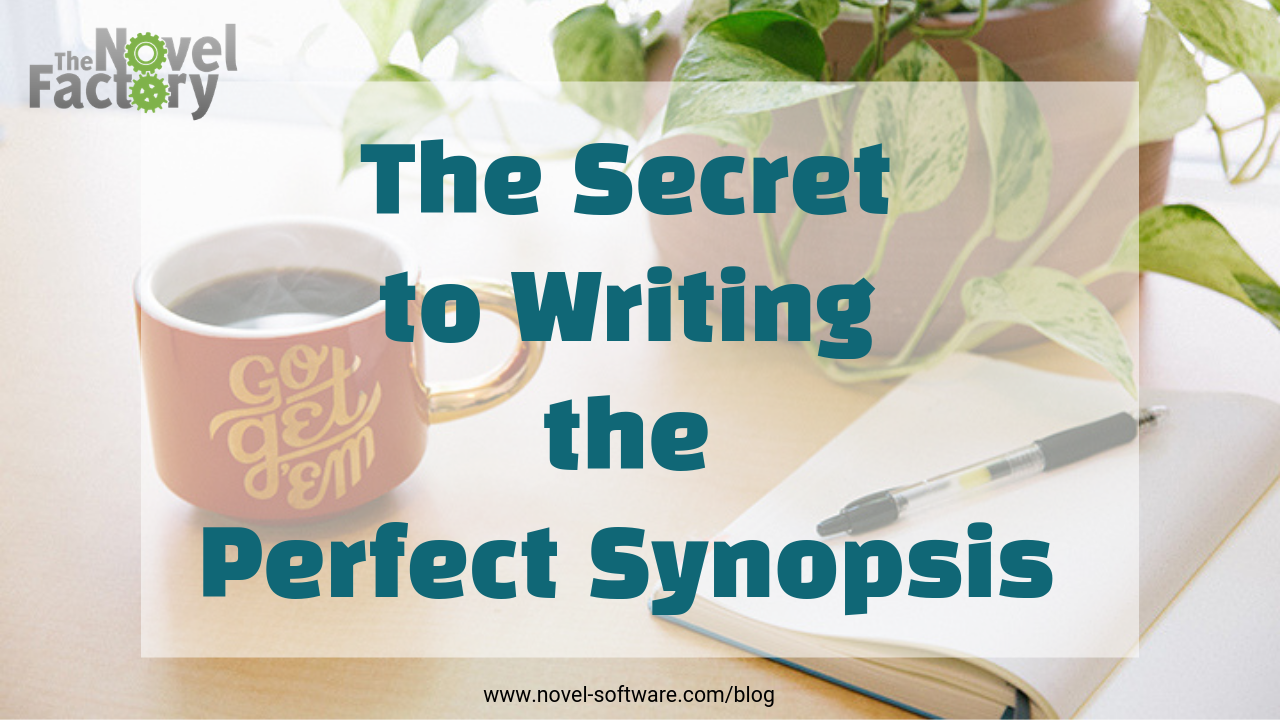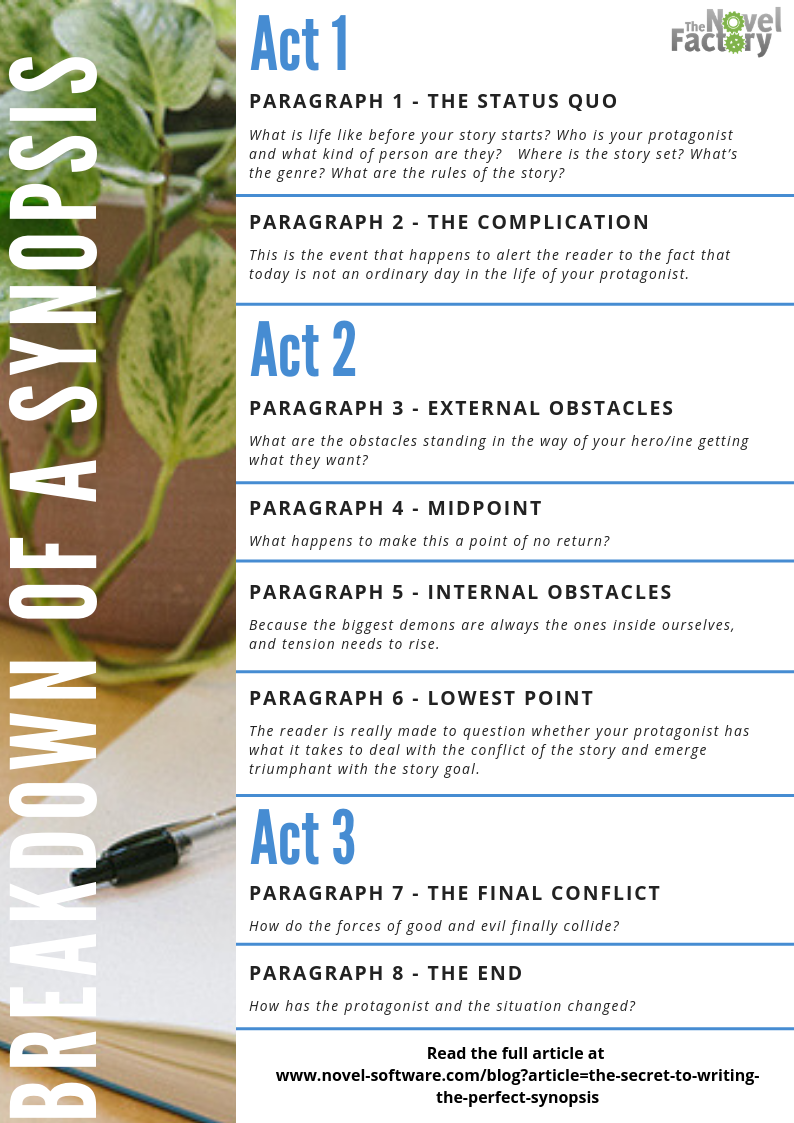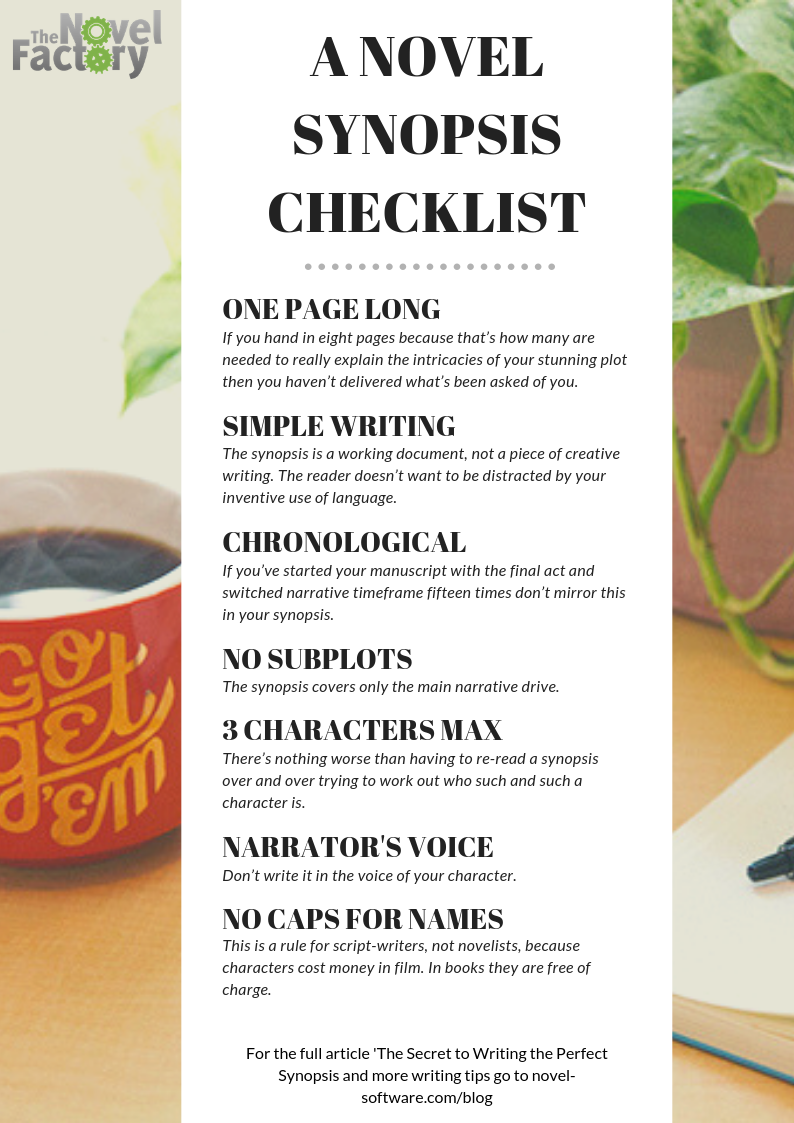
The Secret to Writing the Perfect Synopsis
This is a guest post by Ali Harper, author of The Disappeared (HarperCollins).
Unsurprisingly, every novelist I know hates writing synopses.
Of course we do. Writers are creative beings and we’ve just spent the last god-knows-how-long trying to imagine something that wasn’t there and having conversations with people who don’t exist.
We’ve grown a germ of an idea into a feature-length story and now we’re being asked to boil ninety thousand words down to three hundred. It’s always going to hurt.
However, a synopsis is an essential part of a submission package to an agent/publisher.
A synopsis is needed to show that you understand story structure (i.e what a reader expects from a story) and because, when an agent comes to sell the concept, they need to be able to summarize the plot.
So how do you show you understand story structure?
Simple.
Break your synopsis down into eight paragraphs, which mirror the eight sequences of your story.
Act One
Paragraph One introduces the status quo – what is life like before your story starts? Who is your protagonist and what kind of person are they? Where is the story set? What’s the genre? What are the rules of the story?
Paragraph Two introduces the complication (the inciting incident). This is the event that happens to alert the reader to the fact that today is not an ordinary day in the life of your protagonist. Today is the day when something different happens. (The inciting incident introduces the story goal. Once we’ve read this paragraph we will know what our protagonist wants to achieve by the end of the story. This might be true love, world peace, global domination, a new pair of shoes.)
Act Two
The hardest act to write, not least because it’s twice as long as the first or third act.
This section introduces the conflict of the story – what are the obstacles standing in the way of your hero/ine getting what they want?
Some of these obstacles will be external (a deranged ex-lover, a blood-sucking vampire, lack of money, a prison wall), some may be internal (a fear of heights, a past history of abuse).
Paragraph Three may concentrate more on the external obstacles
Paragraph Four explains the midpoint of the story (otherwise known as the point of no return). This is the point of the story where the reader realizes that even if the writer were to pack everything up and send everyone home, the characters cannot return to the status quo. The story has had impact and nothing will ever be quite the same again.
Paragraph Five may focus more on internal obstacles, because the biggest demons are always the ones inside ourselves, and tension needs to rise.
The final paragraph of the second act, Paragraph Six will outline the lowest point. This is the darkest moment of your story, the point where the reader is really made to question whether your protagonist has what it takes to deal with the conflict of the story and emerge triumphant with the story goal.
Act Three
The final two paragraphs cover the climax and the resolution.
Paragraph Seven shows how the forces of good and evil finally collide (the final battle) and what happens when they do.
Paragraph Eight lets the reader know how your story ends. No one likes giving away their own ending, but it’s imperative that you do (although try to do so in a way that makes the reader want to see this for themselves). Is it a happy, ironic, hollow or tragic ending? (Did the main character get what s/he wanted (the external story goal)? Did they get what they needed (the internal?) How is the life of your protagonist impacted? The reader needs some sense of what will happen to the main characters after the story ends.
Here is a handy infographic summarizing the above points, but keep reading to learn more about how an agent will view your submission and the most important purpose of your synopsis.

Synopsis checkpoint questions
After reading the synopsis the reader should be able to answer the following questions without having to stop and think about:
- Whose story is it?
- What do they want?
- What’s stopping them from getting it?
- How does the story end?
If you’ve got all that information across in your synopsis, you’ve shown you understand what story structure is all about and you’ve shown you understand what readers subconsciously expect from a story. This shows that your novel wasn’t a fluke and you’ve done your homework – which means you’re a committed writer and hence will produce more novels.
What is a synopsis really for?
There’s also another really important aspect to writing a synopsis that, in my experience, writers often overlook.
It helps if you can put yourself in the mind of an agent/publisher who will receive hundreds, if not thousands, of submission packages a year. Understanding how a literary agent works, the obstacles and hurdles they face in their daily lives, is crucial to the process.
I worked as an editor for a major literary consultancy for several years. During this time I received hundreds of manuscripts and submission packages, usually as hard copies through the post. Submission packages are fairly standard and include a cover letter, a synopsis and the first pages of your manuscript. There may be minor deviations – some agents may ask for the first ten thousand words, as opposed to the first three chapters – but by and large a submission package contains those three documents – cover letter, synopsis, extract.
Whenever I read a submission package, I always read those three documents in the same order. I’ve asked every agent and publisher I’ve ever met what order they read in and they’ve all said the same. Here’s the order:
-
The Extract
I always read the chapters first, because this is the exciting bit. If the chapters are great, you get this feeling that builds in you, a creeping excitement, like, wow, this is really good.
People who work in publishing love reading, and reading a brilliant book is always great, but there’s something bewitching about being the first person to read it. I guess it’s something akin to what explorers feel, the joy of discovery.
(I’ll be (brutally) honest at this point and say this feeling hardly ever happens (if it happened a lot it might cease to be exciting). In the decade or so that I’ve been reading other people’s work, it’s happened only half a dozen times. There’s no point working hard on a synopsis if the first three chapters aren’t good enough because an agent won’t ever read it.)
-
The Cover Letter
If the chapters are good, I turn to the letter. If the chapters are brilliant, I might break off from them to read the letter, because I need to meet the person behind the talent.
The letter is there to convince the agent that you aren’t the stereotypical mad artist, living amongst the pixies. It’s there to show that you are reasonable, rational, interesting and will be a joy to work with. It’s there to show that you are the only person in the world that could deliver this book. If the cover letter does all that, the deal is done. Fantastic writing by a person you’d want to work with – surely that’s all an agent needs to know?
So what’s the synopsis for?
-
Synopsis
As we’ve already said, the synopsis is there to show that you understand story structure and to enable an agent to summarize the plot when s/he calls the head honcho at Penguin or Harper Collins (I’ve just got this brilliant manuscript, it’s about…)
But there’s more to it than that.
Stand and Deliver
I think, secretly, that this is the real job of the synopsis – to show that you can deliver what has been asked of you.
The job of a writer isn’t limited to writing beautiful, exciting, engrossing stories. You will also be called upon to write biographies, summaries, pitches, the answers to interview questions, blogs, articles, reviews. The synopsis is part of the submission package to demonstrate that you can put your lofty artistic writing goals to one side from time to time to deliver what has been asked of you.
Here are some tips on how to write your synopsis in a way that shows that you can deliver:
- It should be a page long. If you hand in eight pages because that’s how many are needed to really explain the intricacies of your stunning plot then you haven’t delivered what’s been asked of you.
- The synopsis is a working document, not a piece of creative writing. The reader doesn’t want to be distracted by your inventive use of language.
- Don’t try to be clever, different, quirky. Just tell plot in the order that the story happened. If you’ve started your manuscript with the final act and switched narrative timeframe fifteen times (always a risk in a debut) don’t mirror this in your synopsis.
- Don’t include subplots. The synopsis covers only the main narrative drive. No one likes to boil their story down to its bones. It took me a year to write that book and now you want me to sum it up in one page? Yes, it’s annoying, but it’s what’s been asked of you.
- Don’t introduce your entire cast. There’s nothing worse than having to re-read a synopsis over and over trying to work out who such and such a character is. Hang on, which one is Diane? The synopsis centres on the journey of the main character and no one else.
- Don’t write it in the voice of your character.
- Don’t use capital letters for characters’ names. This is a rule for script-writers, not novelists, because characters cost money in film. In books they are free of charge.

Remember an agent wants to find great manuscripts. They are out there, scouring the far corners of the globe, looking for you. They make their living from you. You are their bread and butter, their golden goose. They want you to succeed.
Good luck!
Do you struggle to write your synopsis? Do you have any advice to share with other writers? We’d love to hear your comments below!
Ali Harper’s first novel, The Disappeared, was published by HarperCollins in 2018 and the sequel to it, The Runaway, will follow in September 2019. She writes feminist crime fiction, centred around No Stone Unturned, a Leeds-based Missing Persons’ Bureau and featuring two women investigators, Lee and Jo, on their mission to reunite fractured families.
Ali also had three novels published by an independent press under a different name. She is represented by Jamie Cowen of The Ampersand Agency. The TV rights to her first novel have been acquired by Duck Soup Films.
Ali works as an editor, tutor and mentor. Further details about the services she offers to writers can be found at https://retreat-retreat.co.uk/.
